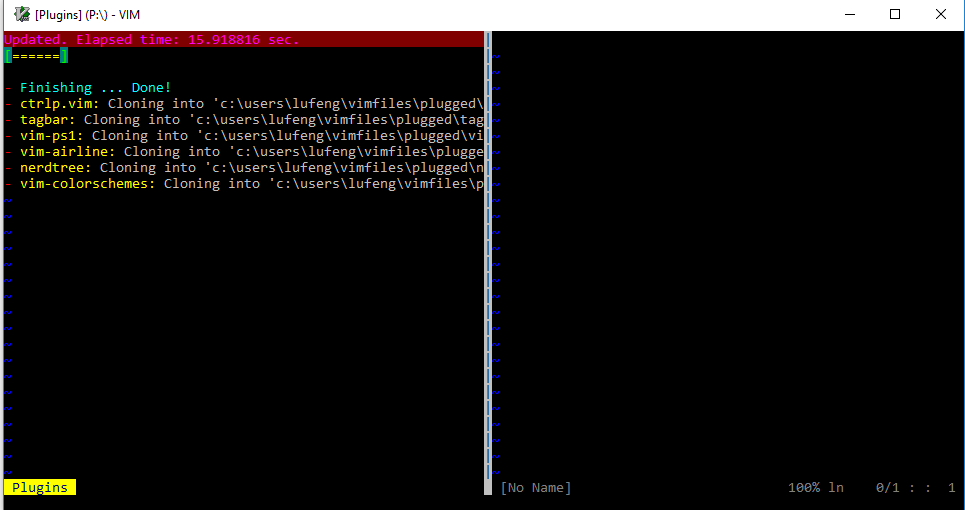

- INSTALLING VIM PLUGINS HOW TO
- INSTALLING VIM PLUGINS INSTALL
- INSTALLING VIM PLUGINS ARCHIVE
- INSTALLING VIM PLUGINS PATCH
However, thanks to the vim-plug tool the process is much easier.
INSTALLING VIM PLUGINS INSTALL
To install Plugins in VIM we have several ways including manual installation. Install and configure VIM plugins on Ubuntu 20.04 While set mouse=r allows us to interact with the mouse in desktop environments.

For example, set paste allows us to use the clipboard to paste items. What these variables do is add some settings to VIM. However, it is advisable to make some configurations to get VIM working properly.īy default, the global configuration file is /etc/vimrc but the local user configuration file is ~/.vimrc which is the one we will use. To install it on Ubuntu 20.04, just open a terminal from the main menu or by pressing the keys CTRL + ALT + T and run the following sudo apt updateĪfter this, you can run it from the terminal and create/edit text files. Support for hundreds of programming languages and file formats.Vim is rock stable and is continuously being developed to become even better. It is included as “vi” with most UNIX systems and with Apple OS X. Vim is a highly configurable text editor built to make creating and changing any kind of text very efficient.
INSTALLING VIM PLUGINS HOW TO
What is Vim and how to install it on Ubuntu 20.04? Today in this post, you will learn how to install and configure VIM plugins on Ubuntu 20.04. One of these improvements is the possibility to add plugins to the editor. But in open source, some want to contribute and as a result, VIM was born as an independent program that adds improvements to Vi.

Although it was not very easy to use, it was the most stable there was. With all this set up correctly, you get a Vim statusline that looks gorgeous and shows lots of useful information, both in terminal and GUI modes.Vi is one of the mythical text editors of Unix. To view these status symbols and messages, install these three plugins: syntastic (for syntax checking), fugitive (for Git) and hgrev (for Mercurial). The plugin can show information on syntax errors and also version control information for Git and Mercurial. If you are on Windows and using Consolas, either directly or through SSH with PuTTY, I have more information in another post.įor other fonts and setups, use the script and directions in the fontpatcher directory. Follow the instructions on that page to install the fonts. If you are on Ubuntu and using the default Ubuntu Mono font, then a patched version of this font can be obtained here.
INSTALLING VIM PLUGINS PATCH
For this to work, you need to patch your font and use that patched font for your terminal or Vim. The plugin can show symbols if the file is in version control (Git or Mercurial), for the filetype, for the line number and many more. To turn this on, add this line to your vimrc: let g:Powerline_symbols = "fancy" By using Unicode symbols, it can present a more beautiful statusline. One way to turn this on in Vim is by adding this line to your vimrc: set t_Co=256īy default it shows a simple colored statusline. The plugin uses lots of bright colors and needs 256-color support in Vim. The powerline plugin can be installed for Pathogen by cloning its Github repository. This post is about the older vim-powerline plugin.)

(As of this writing, folks are working on a new powerline plugin. The vim-powerline plugin is a great way to jazz up the statusline of Vim and show lots of useful additional information. The statusline in Vim gets the job done: it shows the current mode and the location of the cursor in the currently open file.
INSTALLING VIM PLUGINS ARCHIVE
📅 2013-Feb-17 ⬩ ✍️ Ashwin Nanjappa ⬩ 🏷️ color, consolas, font, fugitive, hgrev, powerline, putty, statusline, syntastic, terminal, ubuntu mono, vim ⬩ 📚 Archive Statusline displayed by vim-powerline How to install and use vim-powerline plugin for Vim


 0 kommentar(er)
0 kommentar(er)
